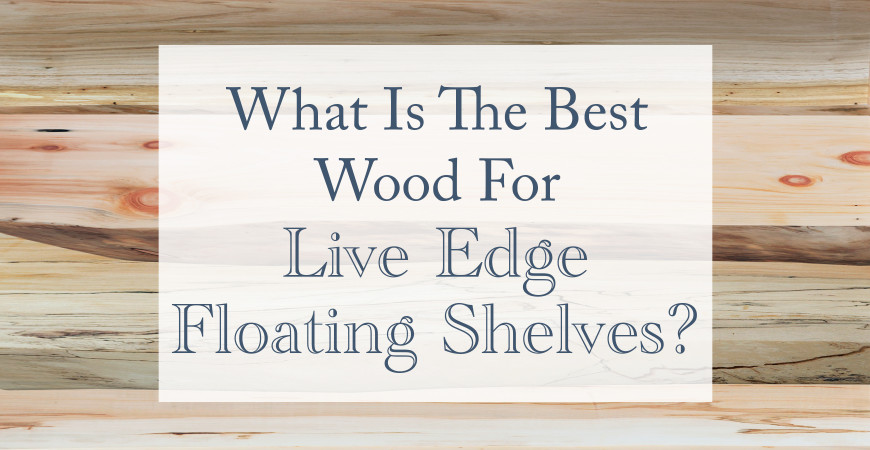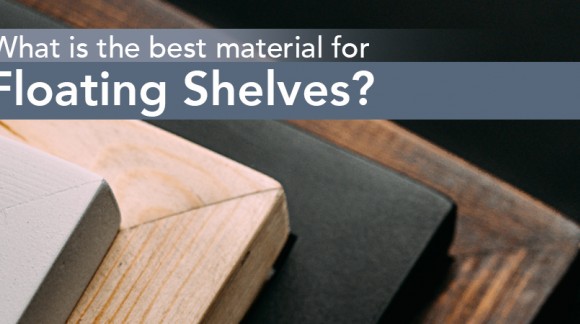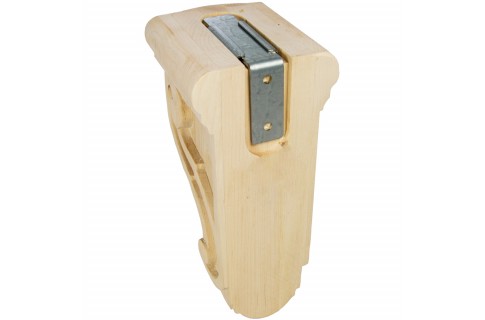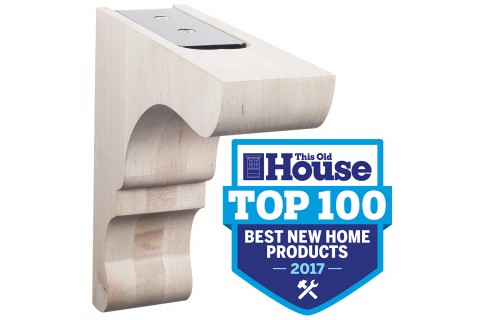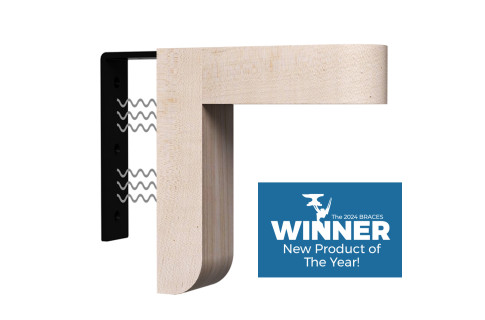What Is The Best Wood For Live Edge Floating Shelves?
Every room in your house tells a story. The good news is that you hold the pen that writes the story it tells. You decorate your home in a way that reflects your personality, allowing it to become an extension of who you are. The design choices you make, from pet beds and house plants to window trim and wall color, has an impact on the atmosphere of your space. It’s important to make choices that suit your needs now, but also your future design goals.
One of the ways people often choose to display their personal treasures, as well as household items to be stored away, is through the creative use of shelving. Today we are looking at available wood types to find the right kind of wood shelving for your perfect floating shelf application.
Let’s answer the question, “What Is The Best Wood For Live Edge Floating Shelves?”
Walnut
Walnut is a dark, rich wood that has hues of gray and purple. Red, as well as contrasting darker tones, stream throughout its grain. This wood tends to be straight and of fine grain, which provides a nice finish for home furniture. Also, walnut is a strong and durable wood that is resistant to decay, allowing it to last for generations.
Walnut is an incredibly versatile wood for home decor. It can be used confidently alongside traditional decor, mid century modern styles, as well as more industrial designs. How this versatile wood is paired with other items in your home makes all the difference. For an industrial design, you may choose to use walnut along with dark toned, or metallic assets, which lend themselves to a more raw architectural design.
Features
- Beautiful color range: the tones in walnut add a warm and rich touch to your home decor. The range of tones throughout the wood makes it versatile and unique.
- Durable: walnut can withstand high humidity environments due to the strength of the wood and the finishing process. It is also exceedingly insect repellant.
- DIY suitable: Walnut is well-suited for staining. Due to its smooth grain, it can be stained with ease for custom DIY projects.
- High-end: Walnut is considered a high-end wood due to its premium quality, and is also considered by most to be one of the most elegant, non-exotic woods available.
Choosing Walnut is choosing a statement piece that is just right for your personal design goals. Walnut does lighten over time, but there is no denying that its rich color is sure to please the eye forever.
Sycamore
Sycamore trees are primarily composed of sapwood. Sapwood,the living layer of the wood, is lighter and softer. Sycamore has the added detail of darker heartwood streaks, which create an intricate design. The grain of the wood is interlocked and made of a fine and even texture, similar to maple.
Sycamore is ideal for rustic home designs. The rustic style is centered on natural beauty and organic elements. Because of its detailed design, sycamore wood makes the perfect organic touch to rustic architecture. Utilizing sycamore on a minimal level can be the perfect accent to a contemporary or modern home design. Adding a pop of sycamore, along with a clean and sleek design aesthetic, makes for the perfect design touch.
Features
- Unique pattern: due to the mix of sapwood and heartwood, sycamore has a unique pattern with heavy contrast. The distinction makes the wood a striking home feature.
- Strong: while sapwood does tend to be softer, it is still a strong wood that is great for shelves and furniture. Sycamore is resistant to cracking and splitting.
- Fire resistant: sycamore is classified as a fire-resistant wood. This means that a fire-causing object being placed on the wood is unlikely to cause an unfortunate house fire.
The heavily interlocked grain of sycamore makes the shelf recognizable as a species, landing it as an excellent choice as a statement piece. It’s sure to get your next dinner party talking!
Pine
Pine is another type of wood that has a distinctive mix of sapwood and heartwood. The heartwood has a medium reddish tone while the sapwood has a lighter yellow tone. The combination adds a touch of warmth to your home decor. The grain of pine is straight, with a tendency to have visible knots.
Pine is an excellent choice for a farmhouse home design. The cozy warm tones complement the neutral and pastel shades of the farmhouse style. Pine is also a staple in the Bohemian home style. Bohemian is all about light, but also warmth with the addition of plentiful textures throughout a room. Pine provides a comforting warmth while also bringing a unique pattern to your space.
Features
- Lightweight: pine is a lightweight wood which makes it easy to work with. It also makes moving or rearranging a breeze.
- Resists shrinking and swelling: this feature makes the wood durable in moist, humid conditions. Pine holds its shape while naturally resisting the shrinking and swelling process.
- DIY friendly: due to the straight grain of pine wood, it works well with stain or paint. The lighter tone also allows a greater variety of stain colors, each picking up pine’s natural red and yellow undertones.
- Strong: despite being a soft wood, pine is still a strong wood. This makes it perfect for furniture.
Pine is the ideal option for warmth and comfort in your home. The softness of the pine can lead to nicks and dents overtime, which can add character to the piece’s finish. This may not be for everyone, but is definitely for those looking for a one-of-a-kind.
Maple
Maple features a light, creamy color that is neutral in tone. Unlike most woods, maple is valued primarily for its sapwood, and is harvested for this purpose. It suits a multitude of decor styles, and it is a wonderful home feature. The grain pattern is straight with a smooth finish, making it incredibly versatile.
Driftwood and similar styles are a staple in the coastal interior style. Maple has a similar resemblance to driftwood, but is much more versatile in its usage. Adding the light and creamy look of maple to shades of blues within a room will create a perfect coastal oasis. Maple also has the ability to bring a touch of interest to a minimalist interior design. Minimalist decor is simple and clean. Maple wood has the simple design and clean colors of the style. However, maple has a touch of design in the wood that makes it the perfect detail feature for a minimalist home.
Features
- Durable: maple is durable and long-lasting against dents and nicks. The wood has an impressive density and strength which makes it perfect for furniture that will endure a little tough love.
- Great for DIY: due to maple’s straight grain pattern and neutral tone, it tends to be very successful with staining. Your DIY dye or stain job will look great each time.
- Naturally dust resistant: maple’s natural dust resistance can be one positive step forward in the journey of managing household allergens. This resistance to dust also makes maple easy to clean and maintain.
The adaptability of maple makes it an excellent choice for any home decor. The straight grain and light color of maple allows you to achieve a durable and minimalist home accent.
Hickory
Hickory trees are another wood type that varies in color. The sapwood of hickory tends to be white or cream colored with a neutral tone. The heartwood is a tan color with reddish undertones. The contrast of the two creates a statement, and the neutral tone makes it perfect for any home style. Hickory has a straight grain that includes a subtle wave pattern. This makes it a slight elevation from the typical straight-grained wood.
Hickory is a great addition to a rustic home decor style. Compared to sycamore, hickory has a brighter tone that complements a lighter rustic style. It is paired well with organic decor such as greenery and natural textures. The raw edge would also be perfect for an airy cabin or cottage.
Features
- Strong: hickory is a dense wood, which allows it to be durable and scratch resistant. It is one of the hardest woods available in the US, which makes it a popular choice for any home.
- Scratch resistant: hickory is a scratch resistant wood due to its density and hardness. Impacts with objects will not damage the surface of the wood.
- Easy Maintenance: thanks to the durability of the wood, it requires very little maintenance. There is no need for special cleaning or upkeep.
Hickory is an amazing choice for those looking to add texture to their home interior. Due to the hardness of the wood, hickory is not ideal for stain or paint. However, the colors and contrast of this wood type are eye-catching as is.
Elm
Elm ranges from light brown to gray in tone. The sapwood and heartwood are separated with distinctive light colored stripes, which allowsElm to stand out. Elm’s grain pattern tends to be straight and smooth, with subtle waves that add interest for the eye. The grains may also be sprinkled with earlywood pores in continuous rows.
Elm is a terrific option for a darker and warmer coastal interior design. The warmth of elm wood is reminiscent of sand and sun, and can truly tie together a coastal home. Elm is also suitable for a rustic interior design. The warm tone emphasizes the natural features of a rustic home. A raw edge also adds an extra organic element.
Features
- Durable: although a softwood, elm is tough and has a natural resistance to environmental elements. Elm is dense and much harder than most softwoods. The density of elm makes it split resistant and durable.
- DIY friendly: elm wood is easy to stain and paint. The smooth texture and straight grains make for a beautiful finish and easy application.
- Decay resistant: if kept dry, this is a long-lasting wood that you can have in your home for years to come as it is naturally resistant to the elements, and ultimately decay.
The tones and striping of elm wood will thrive in any home as accent decor. The refined wood does need periodic sealer and care to maintain its beautiful appearance.
Our aim in this blog was to assist you with answering the question, “What Is The Best Wood For Live Edge Floating Shelves?” but this information could also lead you to more things to think about before you can answer it for yourself.
The truth is no matter your choice of floating shelf finish, the wood will be unique and a true reflection of your personality. Each of our Live Edge Floating Shelves comes in a kit with the Floating Shelf Support Rod Bracket to optimize your storage capabilities. What kind of story are you going to tell with your floating shelf?
Not interested in Live Edge Floating Shelves? Take a look at our entire library of shelving HERE. We offer a variety of other floating shelves, but also: brackets, home accessories, and more. We are constantly developing new products to meet our customer’s needs and our customer service is always available to help if you have questions. We can be reached via phone at 704-755-8003 or through email at customerservice@federalbrace.com.
Happy Decorating,
The Federal Brace Team.
